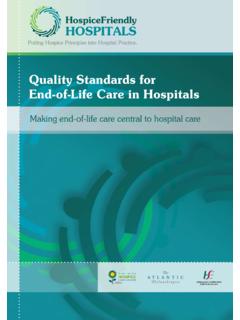Transcription of Care Resources Dying Patient - Hospice Foundation
1 Staff Resources Dying & death in an Acute HospitalCaring for a Dying PatientEnd-of-Life care Resources End-of-Life care resource Folder Version 1 Caring for a Dying Patient1 Caring for a Dying PatientThis section details key areas to consider when caring for a Patient where death is imminent. When possible it is important to agree goals for end-of-life care with the Patient , family and staff involved in delivery of care . Communication is crucial to ensure that key messages are appropriately shared. It is also important to document the decisions relating to Patient care , key conversations and the day-to-day goals of consider if the Specialist Palliative care Team needs to be consulted, to help in Patient management, particularly when there are:1.
2 Complex symptom control issues2. Complex emotional issues3. Children or vulnerable adults who are facing bereavementThe key to managing and supporting the Dying Patient involves:1. Identifying that the Patient is dying2. Continuous assessment of symptoms & psychological/spiritual needs3. Anticipating likely problems before they arise so that treatments are readily available 4 . Appropriate & prompt management of symptomsStrategic goals for the Dying Patient Both the Patient s/family s awareness & understanding of diagnosis of Dying is communicated and documented.
3 Patient is assessed and a care plan is developed in line with the Patient s/family s wishesClinical goals for the Dying Patient Current medication assessed & non-essential medicines discontinued PRN subcut meds/fluids written up as appropriate - see table below Inappropriate interventions discontinued blood tests, BP monitoring. Cardiac defibrillators (ICDs) deactivated in consultation with cardiologist DNAR order completed Organ donation consideredOngoing assessment goals for the Dying Patient Patient is free from pain, agitation, excessive respiratory tract secretions & nausea/vomiting, severe breathlessnessThe information below is from the Hospice Friendly Hospital Programme s Map for End-of-Life 114/09/2010 15.
4 54 End-of-Life Resources2 Caring for a Dying Patient Pressure care - if death is imminent, reposition for comfort only consider pressure relieving mattress Bowel care Patient is free from bowel problems causing distress Urinary status Patient has appropriate aids Eyes, mouth & lips clean & moist - consider family involvement in these tasks, if appropriate Emotional & psychological care Patient and family have appropriate support Spiritual, religious and cultural support needs are assessed and supported GP and community team informed of the Patient s condition Goals to support the family as the Patient nears death Next-of-kin / significant others identified & contact details recorded.
5 Family prepared as far as possible for the Patient s death Details of facilities provided free car parking, washrooms, visiting times, family physical symptoms associated with dyingRegular / PRN subcutaneous medications1. PainAnalgesics ( )2. Agitation & distressSedatives ( midazolam)3. Respiratory tract secretions ( noisy rattle )Anti-cholinergics ( hyoscine hydrobromide)4. Nausea & vomitingAnti-emetics ( metoclopramide )5. BreathlessnessAnxiolytics ( midazolam) 214/09/2010 15:54 End-of-Life care resource Folder Version 1 When A Patient Is Dying3 When a Patient is Dying A guide for staff on the process & symptoms of Dying .
6 The contents of the booklet are included on the following pages. This booklet is also available to download at is End-of-Life care Difficult? How do we know if somebody is Dying ? Patterns of Dying Dying trajectories Process of Dying Management of the Dying process Difficult death Handling difficult questions Spiritual care Pronouncing death and death certification care after death After death analysis End-of-Life care resource Folder Version 14 When A Patient Is DyingWhen a Patient is
7 DyingLooking after patients who are Dying makes many of us feel a little uncomfortable. What we should be doing or saying is often unclear. Although we feel we should be doing something to help we can often be uncertain what that something is. Some of this uncertainty arises because being in contact with people who are Dying is neither a common experience nor is it easy to talk about or seek advice on how we should be responding and helping. Some people deal with this part of being a health professional by developing a black sense of hu-mour, others retreat to avoid all but the most minimal contact with the Dying and their relatives.
8 Even though staff may have been working for many years they may not have learned or developed their skills and knowledge in this very important part of our section aims to outline some of the important facts about end-of-life care in Ireland and pro-vide practical advice about managing this particularly significant part of About People Dying in IrelandAbout 30,000 people die in Ireland each year, 48% in acute and 23% in longterm care facilities. A third of these deaths (10,000) occur as a result of organ failure, heart failure or chronic obstructive pulmonary disease.
9 A third (10,000) are as a result of generalised frailty and dementia. A quarter (7,000) are due to cancer. A twelfth (2,400) are sudden unpredicted is End-of-Life care Difficult? It can make health care workers feel uncomfortable that in some way we have failed to make this Patient better - what do you do when there is nothing more curatively that can be done?We can be uncertain what is appropriate to say or do when we are with such patients and their each death is a unique and profound event, paradoxically, many of the most crucial components of care of this especially vulnerable group are universal, and need to be anticipated and planned for in a practical and rigorous manner within hospital systems and practice.
10 It can make us feel uncomfortable either by reminding us of our own mortality or of a bereavement we ourselves have experienced. `End-of-Life care resource Folder Version 1 When A Patient Is Dying5It may seem strange that we who manage care of people at the end of life can so quickly feel out of our comfort zone in such End of LifeThe process of Dying can be compared to the process of giving birth in that they are both intensely personal and emotive events, and yet each birth and each death also share a great deal in common with every other birth or death .











